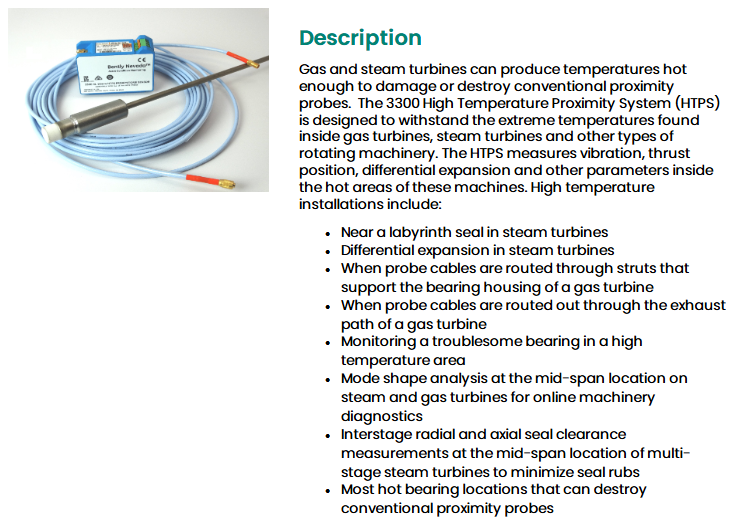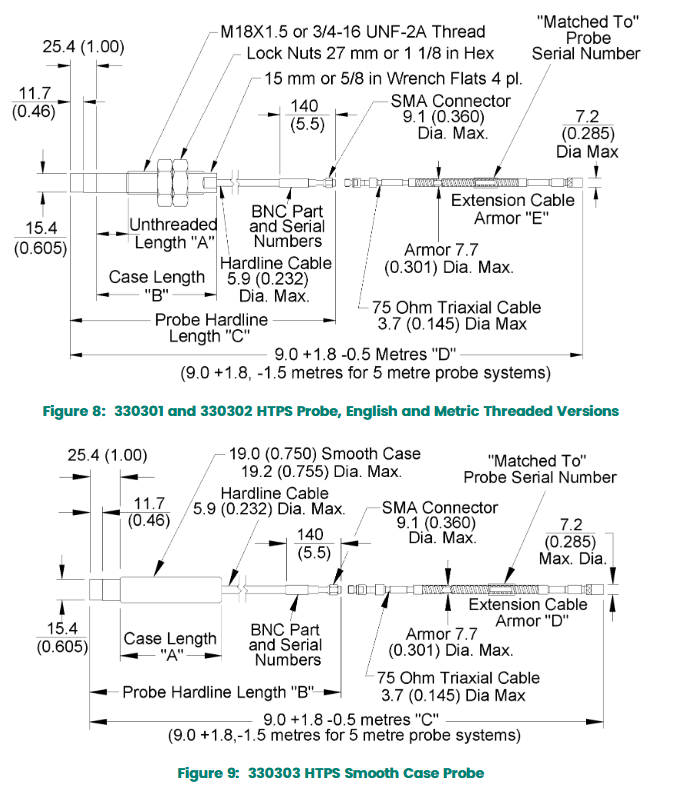Bently Nevada 3300 XL High Temperature Proximity Detection System (HTPS)
Combining the dual value of "online monitoring and protection" and "research and development/troubleshooting": it is used for real-time protection of key equipment in industrial sites, and also supports turbine mode shape analysis, helping new machine research and development and old machine fault diagnosis (such as shaft cracks, bearing failures, dynamic and static friction, etc.).
Bently Nevada 3300 XL High Temperature Proximity Detection System (HTPS)
System core positioning and application scenarios
1. Core positioning
Addressing the pain point of traditional proximity probes being easily damaged in high-temperature environments, it can operate stably in continuous high temperatures up to+350 ° C (+662 ° F) and is used to measure key parameters such as vibration, thrust position, and differential expansion. It is compatible with Bently Nevada's entire range of monitoring and diagnostic equipment.
Combining the dual value of "online monitoring and protection" and "research and development/troubleshooting": it is used for real-time protection of key equipment in industrial sites, and also supports turbine mode shape analysis, helping new machine research and development and old machine fault diagnosis (such as shaft cracks, bearing failures, dynamic and static friction, etc.).
2. Typical application scenarios
Focusing on the high-temperature areas of gas turbines and steam turbines, including:
Near the labyrinth seal of the steam turbine, differential expansion measurement points;
Gas turbine bearing seat support pillar, probe for threading in exhaust path;
Monitoring of faulty bearings in high-temperature areas;
Modal analysis and online diagnosis of turbine mid span position;
Measurement of inter stage radial/axial sealing clearance at the mid span position of a multi-stage steam turbine to reduce sealing friction.

Core advantages and design features of the system
1. Extreme environmental adaptability
High temperature tolerance: The probe integrates a hard wired cable, with a rated continuous working temperature of+350 ° C (+662 ° F), far exceeding traditional probes;
Durable structure: Ceramic probe tip (sealed, moisture-proof, and anti pollution)+AISI 316L stainless steel shell (corrosion-resistant), can withstand 100% condensation humidity, and the probe connector can be submerged after protection;
Flexible installation: Available in two styles: threaded housing (3/4-16 UNF, M18 × 1.5) and smooth housing. The smooth housing is paired with a clamping mounting bracket to solve the problem of difficult calibration in traditional threaded installation of long cable probes (2m/5m).
2. Performance and compatibility
Measurement accuracy: Linear range of 4.0mm (160 mil, 0.5-4.5mm interval), incremental scaling factor (ISF) of 3.94 V/mm (100 mV/mil), best fit line deviation (DSL) of ≤± 78 μ m (± 3.1 mil), ISF deviation at high temperature (22-350 ° C) of ≤± 30%;
Fully compatible design: The signal output (3.94 V/mm) is compatible with all new and old Bently Nevada monitoring devices, supports field wiring up to 305 meters (1000 feet), and has a frequency response of 0-6kHz (± 0, -3dB).
Core technical specifications
1. Electrical specifications (default test conditions: 22 ± 4.4 ° C, 2000m altitude, -24Vdc power supply, AISI 4140 steel target)
Category key parameters
Power supply requirements input voltage -19.6~-26Vdc, maximum power consumption 12mA; voltage higher than -23.5Vdc will shorten the linear range
Output characteristics: Output resistance 50 Ω, power supply sensitivity ≤ 13mV/V (output change ≤ 13mV for every 1V change in input voltage)
Probe resistance 1m Probe: 5.06 Ω; 2m probe: 5.82 Ω; 5m probe: 8.11 Ω (center conductor outer conductor)
Extended cable capacitance 69.9pF/m; 4m cable resistance: core wire 0.88 Ω, coaxial conductor 0.26 Ω; 7m cable: core wire 1.62 Ω, coaxial conductor 0.49 Ω
2. Mechanical and environmental specifications
Category key parameters
Material probe housing: AISI 316L stainless steel; Hardwire cable: AISI 304L stainless steel; Extension cable: FEP insulated 75 Ω triaxial cable; Sensor housing: epoxy powder coated aluminum
The total length of the size and weight system is 9m (including extension cables); Probe weight 117g/m (cable)+12g/cm (casing); Sensor weight 255g (9oz)
Maximum tensile strength of 289N (65 pounds, probe extension cable); The maximum torque of the probe housing is 81N · m (720 in. lb); Minimum bending radius 25.4mm (1in)
Temperature range probe: -34~+350 ° C (storage/operation); Extension cable: -52~+177 ° C; sensor: working -52~+100 ° C, storage -52~+105 ° C

Hardware composition and model classification
The system core consists of "probe+extension cable+Proximitor Sensor", and each component model is subdivided by function, supporting customized selection:
1. Core probe model (Class 3)
Example of Key Parameters for Model Series Type Selection
330301 3/4-16 UNF threaded housing A (unthreaded length, 0.0-5.4in, 0.1in increments), B (total housing length, 1.1-6.5in, 0.1in increments), C (hard wire length: 10=1m/20=2m/50=5m), D (total length: 90=9m), E (armor: 00 none/01 present), F (certification: 00 not required) 330301-012-060-10-90-00-00 (unthreaded 1.2in, housing 6.0in, hard wire 1m, total length 9m, no armor, no certification)
330302 M18 × 1.5 threaded shell A (unthreaded length, 0-130mm, 10mm increments), B (total shell length, 30-160mm, 10mm increments), C/D/E/F are the same as 330301 330302-050-130-20-90-01-00 (unthreaded 50mm, shell 130mm, hard wire 2m, total length 9m, armored but not certified)
- EMERSON
- Honeywell
- CTI
- Rolls-Royce
- General Electric
- Woodward
- Yaskawa
- xYCOM
- Motorola
- Siemens
- Rockwell
- ABB
- B&R
- HIMA
- Construction site
- electricity
- Automobile market
- PLC
- DCS
- Motor drivers
- VSD
- Implications
- cement
- CO2
- CEM
- methane
- Artificial intelligence
- Titanic
- Solar energy
- Hydrogen fuel cell
- Hydrogen and fuel cells
- Hydrogen and oxygen fuel cells
- tyre
- Chemical fiber
- dynamo
- corpuscle
- Pulp and paper
- printing
- fossil
- FANUC
- Food and beverage
- Life science
- Sewage treatment
- Personal care
- electricity
- boats
- infrastructure
- Automobile industry
- metallurgy
- Nuclear power generation
- Geothermal power generation
- Water and wastewater
- Infrastructure construction
- Mine hazard
- steel
- papermaking
- Natural gas industry
- Infrastructure construction
- Power and energy
- Rubber and plastic
- Renewable energy
- pharmacy
- mining
- Plastic industry
- Schneider
- Kongsberg
- NI
- Wind energy
- International petroleum
- International new energy network
- gas
- WATLOW
- ProSoft
- SEW
- wind
- ADVANCED
- Reliance
- YOKOGAWA
- TRICONEX
- FOXBORO
- METSO
- MAN
- Advantest
- ADVANCED
- ALSTOM
- Control Wave
- AB
- AMAT
- STUDER
- KONGSBERG
- MOTOROLA
- DANAHER MOTION
- Bently
- Galil
- EATON
- MOLEX
- Triconex
- DEIF
- B&W
- ZYGO
- Aerotech
- DANFOSS
- KOLLMORGEN
- Beijer
- Endress+Hauser
- MOOG


Email:wang@kongjiangauto.com
























































































